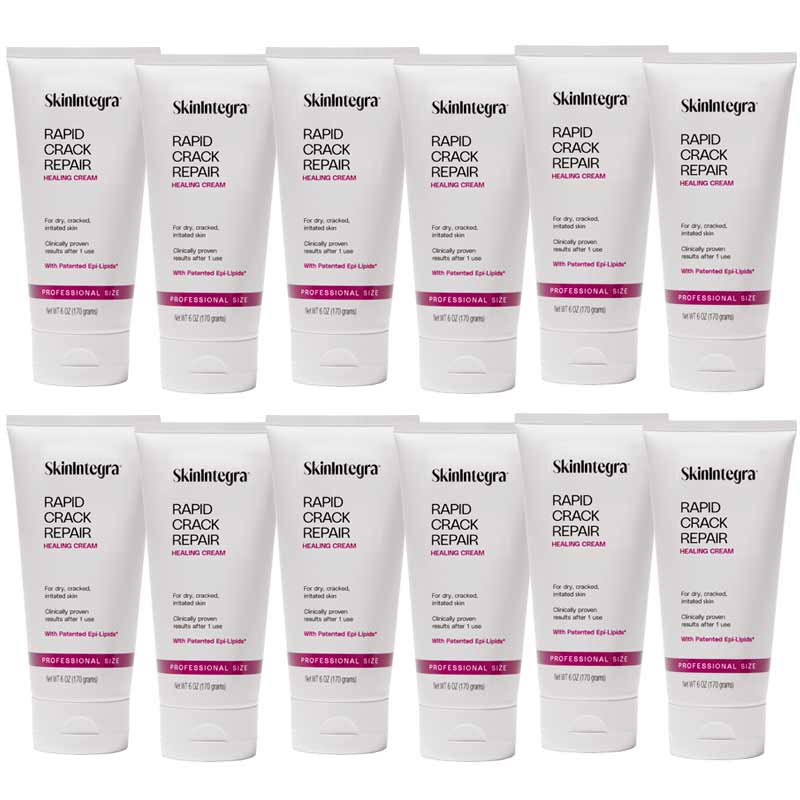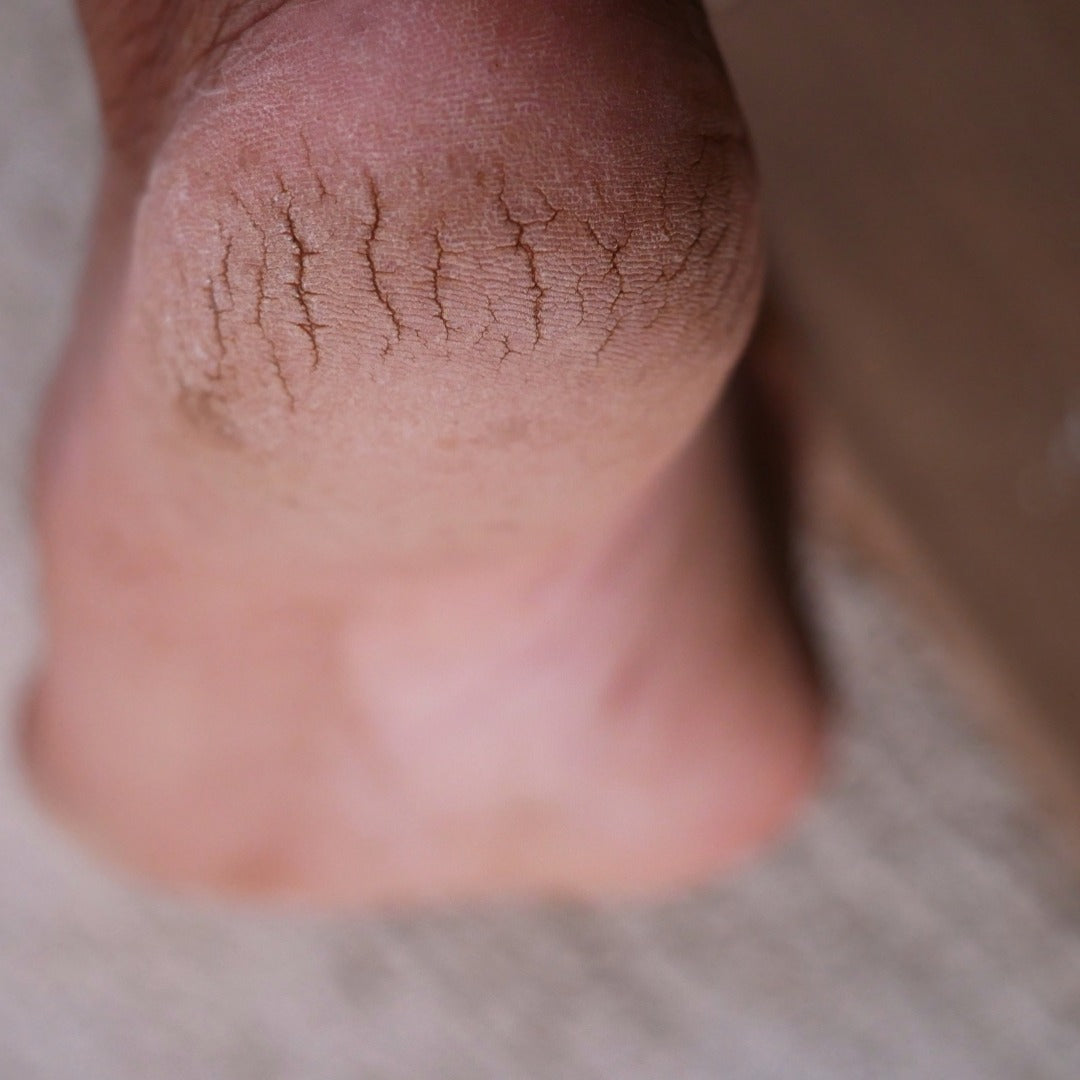Cracked heels and split fingertips are more than just a cosmetic issue—they can be deeply painful and disruptive to everyday life. If you've tried moisturizing with little success or find that your skin keeps splitting in the same spots, you're not alone. Many people, especially those with diabetes, eczema, or frequent hand washing habits, struggle with skin that simply won't heal.
Cracked skin is not only a discomfort; it's a sign that your skin barrier has been compromised. This barrier plays a crucial role in keeping moisture in and harmful irritants and bacteria out. When it breaks down, the skin becomes dry, inflamed, and prone to deeper damage. In people with diabetes or chronic skin conditions, these cracks can worsen quickly and take longer to heal.
In this article, we'll explain why cracked heels and cracked fingertips happen, what prevents healing, and what actually works. We'll also introduce you to SkinIntegra—a patented barrier repair cream clinically tested to improve dry, fissured skin safely and effectively.
Image of cracked heels

Common Causes of Cracked Fingertips and Cracked Heels
Cracks typically form when the skin barrier becomes too dry, weak, or inflamed to stay intact. These fissures often appear on high-friction areas like fingers, thumbs, and heels.
Top Contributing Factors:
-
Vitamin deficiencies (especially vitamin D, zinc, and essential fatty acids)
-
Frequent hand washing or sanitizer use with harsh ingredients
-
Cold, dry climates or excessive indoor heat
-
Psoriasis or eczema flares — see how psoriasis affects the feet
-
Diabetes-related poor circulation and neuropathy — why diabetic skin is more prone to cracks
-
Dehydration and poor skin nutrition
Other overlooked causes include wearing open-backed shoes that create friction on the heels, standing for long periods on hard surfaces, and using household cleaners or gardening without gloves.
Left untreated, minor cracks can deepen, bleed, and create openings for infection. In people with diabetes or healthcare workers, these risks are especially serious.
Why Your Cracked Heels and Fingers Won't Heal
If you're using regular moisturizers and still struggling, there are two common reasons:
1. Your Skin Barrier Is Too Compromised
Basic moisturizers might temporarily soften skin, but they lack the ingredients needed to rebuild your skin's protective barrier. To truly repair cracked heels or fingertips, a formula must:
-
Replenish missing lipids (fatty acids, ceramides, oils)
-
Attract and retain moisture (with urea, hyaluronic acid, or lactic acid)
-
Avoid harsh irritants that can worsen cracks
Compare the effects of urea vs. lactic acid
2. You're Dealing with Skin Fissures, Not Just Dryness
Fissures are deeper cracks that extend into the dermis. They often occur on cracked heels and fingertips and resist healing without targeted intervention. In people with diabetes, poor circulation slows healing even further.
Once skin fissures develop, they often reopen with daily movement, walking, or gripping tasks. This not only delays healing but also increases the risk of infection. Treating these cracks early and aggressively can help prevent longer-term complications.
How to Treat Deep Cracks and Cracked Heels Safely
To heal cracked heels or fingertips effectively:
1. Clean and Protect the Area
-
Gently cleanse with lukewarm water (avoid hot water)
-
Apply a thin layer of antibiotic ointment if bleeding
-
Cover with gauze or waterproof bandage
2. Apply a Barrier Repair Cream Twice Daily
Use a product designed for fissured skin with:
-
Urea (to exfoliate and soften hard skin)
-
Lactic acid and hyaluronic acid (to hydrate)
-
Ceramides, essential oils, and fatty acids (to restore the barrier)
Avoid creams with fragrances, dyes, parabens, or petroleum which can irritate sensitive skin.
Learn how to treat cracked heels that bleed
3. Limit Triggers and Support Healing
-
Wear gloves when washing dishes or using cleaners
-
Avoid repeated soap use (opt for barrier-friendly cleansers)
-
Use a humidifier during dry seasons
-
Stay hydrated and eat foods rich in skin-supporting nutrients like omega-3s, vitamin C, and zinc
If cracked skin is chronic or worsens with treatment, see a healthcare provider to rule out infection or underlying conditions.
SkinIntegra: Clinically Tested for Healing Cracked Heels and Hands

SkinIntegra’s Rapid Crack Repair Cream is a patented solution for painful, cracked heels and fingers. Developed with input from podiatrists and dermatologists, it's designed to:
-
Gently and effectively exfoliate callused skin while supporting skin renewal with 25% urea and lactic acid
-
Support skin barrier recovery with hyaluronic acid, ceramides, omega fatty acids, and natural oils
-
Avoid common irritants like fragrance, dyes, parabens, petroleum, and phthalates, making it safe for use even on fissured skin without causing stinging
It has also earned the Seal of Approval from the American Podiatric Medical Association (APMA), confirming its safety and effectiveness for use on diabetic skin.
Whether you're a healthcare worker with split thumbs or a person with diabetes dealing with cracked heels, SkinIntegra offers real relief—fast.
“I was surprised at how fast the product produced results. I also have heard from patients that their heels are well hydrated and they have used it on dry cuticles!” — Dr. Karen Luther, Board Certified Podiatrist, Pennsylvania
Additional Skin Care Tips to Prevent Recurrence
Once your skin is on the mend, ongoing care is key to preventing new cracks:
-
Moisturize after every hand wash or shower. Lock in moisture while the skin is still damp.
-
Use silicone socks or gloves overnight to boost absorption of rich creams.
-
Avoid walking barefoot or wearing open-backed shoes on hard surfaces.
-
Choose non-stripping hand soaps and limit water exposure when possible.
-
Switch to a daily maintenance moisturizer for your hands and feet to reinforce the barrier.
These preventive measures can dramatically reduce recurrence and help maintain smoother, stronger skin over time.
Shop SkinIntegra Rapid Crack Repair Cream
Ready to finally find relief from deep cracks on your heels or fingertips?
Shop Now and give your skin the care it deserves.
FAQs About Cracked Fingers and Cracked Heels
What deficiency causes cracked fingertips?
Vitamin D, essential fatty acids, and zinc deficiencies are often linked to cracked fingertips.
How do you treat split skin on fingers from handwashing?
Switch to gentle, fragrance-free cleansers and apply a barrier repair cream like SkinIntegra after each wash.
What if cracked heels or fingers bleed?
Clean the area, apply a topical antibiotic, and cover with a bandage. Once bleeding stops, apply SkinIntegra twice daily.
Can people with diabetes use SkinIntegra?
Yes. SkinIntegra is safe for use on diabetic skin and has earned the Seal of Approval from the American Podiatric Medical Association (APMA).
What is the best treatment for cracked heels that won’t heal?
Use a dermatologist and podiatrist-tested barrier repair cream with urea and lipids, like SkinIntegra, and protect the skin from further irritation while it heals.
What’s the difference between dry skin and skin fissures?
Dry skin is a superficial issue, while fissures are deeper cracks that reach into the dermis. Fissures are often painful and require advanced care.





